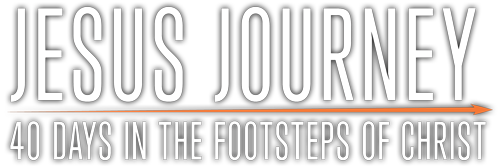Day 9
First Followers
Read Matthew 4:18–22, Luke 5:1–11, Luke 6:12–22
I stand in a museum along the shore of the Sea of Galilee looking at one of the biggest finds in the history of marine archaeology. And I’m getting goose bumps.
The story of this discovery is amazing.
A misty rain broke a long drought here on January 24, 1986. Because of the drought, the water level in the lake had receded dramatically.
On an early morning sail that day, two fisherman brothers saw something curious poking up from the mud in shallow water. They couldn’t believe their eyes: It looked like an ancient boat. In a curious coincidence, at the very same moment, they both looked up and saw a double rainbow.
They suspected they were on to something big, and immediately contacted famous marine archaeologist Dr. Kurt Raveh and Texas A&M biblical archaeology professor Dr. Shelley Wachsman.
Three independent precision carbon-14 tests confirmed the amazing truth: The brothers had found an intact wooden fishing vessel from the time of Christ — the very kind Jesus and his disciples travelled and fished in! It’s now housed in a building near the lakeside community of Kibbutz Ginosaur where we stand and stare.
One curious detail about this boat: It can comfortably seat about… twelve people.
A cooking pot and a lamp and some first-century coins were found in the shipwreck and are also on display at the museum — just normal artifacts of daily life in the first century.
ORDINARY BOAT, ORDINARY MEN
What’s striking about this boat is that it’s so ordinary. Just like the boats Peter and Andrew and James and John used. Or I should say, just like Peter and Andrew and James and John themselves!
In today’s readings, Matthew gives the quick sketch and Luke fills in the details.
These men are busy with the day-to-day responsibilities of fishermen: Fixing nets. Prepping for the next trip. How many times had they done this, over and over again? Following Christ isn’t even on their agenda. Their minds are elsewhere. But Jesus calls them.
This is a huge departure from the way other first-century rabbis gathered disciples. In those days, potential disciples travelled to the teacher they hoped to follow, and asked his permission to become a disciple. In a sense, they applied for an internship.
So in the normal social and cultural protocol of the day, this story never would have happened.
Put yourself in their sandals. Here’s Jesus, standing on the beach, interrupting your day, calling you to follow him.
And Jesus does not even go into long explanations. He simply says, “Follow me.”
Living the Christian life does not mean understanding everything God is doing, or everything Jesus meant. It means following along as Jesus does his thing, around you and in you and with you. Then telling others about this amazing person.
CHOSEN TO FOLLOW
As Jesus will later remind his disciples,
“You did not choose me, but I chose you and appointed you that you should go and bear fruit and that your fruit should abide.” John 15:16
I don’t think Matthew is writing this so that we can admire these guys and think, Wow, how awesome of them to leave everything and follow Jesus; they were spiritual giants! I don’t think Matthew is pointing to the disciples at all; he’s telling us something about how Jesus operates.
He comes to you and me in the middle of our busy lives and says, simply, “Follow me.”
It’s not about your worthiness or your performance or your potential. It’s about his grace.
And notice: “Follow me.”
Not “Work for me.”
Most Christians who burn out in their faith have, at some point, gone from walking with Jesus to working for Jesus. When you think of yourself as working for Jesus you will get resentful and burned out (think of the oldest son in the Prodigal Son parable: “All these years I’ve been slaving for you!” he spouts off to his father, who responds, “My son, all I have is yours…”).
GOD USES NOBODIES
I love that the very first followers Jesus picks seem to be very average. Just normal people doing ordinary things. They weren’t showing promise. They didn’t earn an internship. He is not picking proven A-players. He is showing what he can do with anyone. God can do more with a nobody than anybody else can do with a somebody!
And look who he calls next. Jesus didn’t just call fishermen. The other people represented in his inner circle were an even bigger surprise.
There were three main religious groups in first-century Israel, and they despised each other. They were all focused on getting that longed-for kingdom reboot prophesied in the Scriptures, but they had radically different ideas about how this would be achieved.
ZEALOTS
Here’s the way John Ortberg describes the first group:
Zealots believed that the Kingdom of God would come to Israel when there were enough people who were angry enough to revolt. They chose the way of attack. This was an extreme nationalist party. They were dedicated to bringing in the Kingdom of God by overthrowing the Romans; they would use any means necessary, including violence. 15
PHARISEES
Pharisees believed that rigid adherence to the Law of Moses and all of its 613 commandments was the way for the Kingdom of God to come to earth. They essentially withdrew into a holy huddle to avoid pollution by the pagan world. They wouldn’t even enter a Gentile house. Their strategy was basically withdrawal and rule-following.
SADDUCEES
The most powerful group, the Sadducees did not believe in the Resurrection, the afterlife, angels or spirits. They were interested only in the here and now. The Sadducees looked at the Romans, and thought, Well, if you can’t beat ’em, join ’em. Their strategy was collaboration. They worked with the tax collectors to get money for the Temple system. They had an uneasy alliance with the Roman political powers.
These three groups all despised one another.
Then who does Jesus choose to be his followers, after he starts with the fishermen?
How about… Simon, the Zealot. One of the attackers.
Then there’s Nicodemus, the Pharisee, one of the rule-followers.
And Matthew, the tax collector — one of the Jews who happily collaborated with the very Romans the Zealots wanted to attack.
And how about the Samaritan woman? As Ortberg puts it, in the eyes of all the rest she’s the wrong gender, wrong nationality, wrong religion, and has the wrong sexual history. She stands outside all the walls. 16
But Jesus, as always, is not about walls. He’s about grace.
COLORFUL KINGDOM
Even in his choice of followers, Jesus is showing what kind of a community he came to create. He picks a group of people about as diverse as possible in the first century. A group where what matters is not your ethnicity or history or bank account, but your heart. And he still does.
I look at the group on our Israel tour bus right now. People range from 13 to 73 years of age. Men and women. Republicans and Democrats. English and Spanish and Russian and German speakers. People sporting close-cropped Marine haircuts and Grateful Dead-style ponytails.
But we find our unity in following him.
Maybe you feel like you’ve never really belonged. Like you’ve always been cut from the team, or never invited to join in the first place. Jesus says, Come join my community.
Ponder
Jesus chose widely diverse followers. What implications does this have for your own actions and attitudes? Thank God today that he chooses you!

 Buy Jesus Journey at Amazon.com
Buy Jesus Journey at Amazon.com